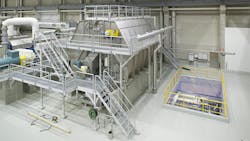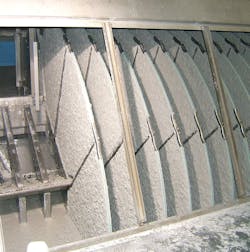For many, the term white water conjures up images of outdoor enthusiasts paddling frantically while going over rapids in a rubber raft. But those familiar with the papermaking process know that white water treatment is more than that. It’s a great opportunity to save money. That’s because white water contains economic benefits in the form of energy, fiber, water and wastewater treatment savings. To realize these benefits and select an appropriate white water treatment process, it’s important to understand the components of a white water system around a paper machine (PM).
White water system basics
A white water system starts with the formation of paper sheets on the wet end of a paper machine. A mixture of hot water and fibers is deposited onto a moving fabric as water drains through, leaving the remaining fibers to form a continuous paper sheet. While on the fabric, the water mixture contains fines, fibers and other materials. These suspended solids create a milky or cloudy appearance in the drainage water, hence the term “white water.”
To improve the efficiency of the papermaking process, the white water from the paper forming process is collected and treated to recover the suspended solids and clarify the hot water. Both the recovered solids and clarified hot water are returned and reused in the front end of the papermaking process. The use of recovered materials and clarified hot water delivers direct economic benefits with reductions in material, energy and water consumption, while also reduced wastewater treatment costs.
Disc filter savealls are the backbone of white water treatment systems for most paper machines producing packaging and printing papers. For tissue and towel machines, disc filter savealls are often used to filter white water. In some cases, a simple a bow screen that recovers only long fiber from the white water can be used, letting the fine material pass with the bow screen filtrate to be removed from the water in a subsequent dissolved air flotation process. For installations limited by available fresh water and where higher purity water is required for critical showers or chemical dilution, ultrafiltration of disc filter clear filtrate or DAF clarified effluent is an option.
The high separation efficiency of a disc saveall is due to the fiber mat forming on the disc surfaces as they rotate into the vat. The fiber mat is formed from long fibers added to the white water known as sweetener fiber. A sweetener is required to build an efficient filtration barrier to collect the fine fibers and small inorganic particles called fillers that make up the suspended solids in white water. The fiber mat and suspended solids that it collects are supported on a fabric or stainless mesh that covers the disc surface.
A saveall application is a key component of a white water system. A high-efficiency vacuum disc filter, the saveall takes the excess white water from the paper machine and recovers fines and fillers in the white water. Sweetener is added to the white water as it enters the saveall and builds filtration mats that are dropped into a repulper and go back out as recovered stock. The water becomes cloudy as the mat builds up; then the water becomes clearer. Most machines in North America only have two filtrates: cloudy and clear.
Cloudy filtrate formed during the beginning of the mat buildup can be recycled back to the saveall feed or can be used for dilution. Clear filtrates are used for the saveall showers and to replace fresh water used on paper machine showers. Since there will be extra water in the paper machine loop, it’s always better to send clear filtrate to effluent to minimize material losses and reduce wastewater treatment costs. Superclear filtrate can be used for low-pressure showers, chemical dilution and seal water. For all these uses, it’s strongly recommended to have a protection filter to ensure high reliability.
In this way, a saveall can ensure lower fresh water and chemical consumption. When selecting a disc saveall, it is important to specify the type and size appropriate for the pulp characteristics and the production capacity. Work with a manufacturer that has experience specifying white water treatment, and offers a wide, versatile array of filtration solutions for high throughput, high quality filtrates (low ppm) and adequate recovered stock consistencies.
There are multiple water treatment technologies an effective system can employ:
- Disc saveall – filters excess PM white water; this is the backbone of white water treatment
- Bow screen – fiber recovery for tissue machine white water and shower water protection
- Ultrafiltration – treats saveall filtrate for high-pressure forming section showers
- Microflotation – removes fines from tissue white water
Each technology can provide distinct benefits and opportunities for savings. By understanding the components of a white water system, the saveall and other available technologies, it’s easy to recognize how white water presents economic opportunities for energy, fiber, water and wastewater treatment savings.
Several types of filtration technologies can treat white water to separate and recover the suspended solids from clarified water. Selection of the appropriate filtration technology depends on the type of paper being produced (e.g., linerboard for packaging, printing paper, tissue, towel), and the degree of purity required in the clarified water. The most common filtration technology used to treat white water is a vacuum disc filter that is appropriately called the paper machine saveall. Other technologies to filter white water for specific applications include bow screens (also called inclined screens), ultrafiltration (UF) and dissolved air filtration (DAF).
Energy savings
Energy and cost savings can be achieved in most PMs by improving water treatment and the use of the excess white water from the forming and press section. Excess white water creates energy savings by increasing the use of hot, filtered water to replace fresh water for showers.
In all cases, including uses of clear filtrate or superclear for showers, it is highly recommended to have a protection filter, also known as a policeman. That’s because savealls have a lot of components, and if a hole becomes worn in the disc fabric, fiber can leak out and potentially clog showers.
Savealls should also be evaluated regularly to ensure they are running efficiently. There are three key performance indicators that should be examined to optimize energy efficiency:
- Identify capacity - Does the system have enough capacity to handle the PM white water and cloudy recycle, and can it support the broke thickening from the saveall?
- Inspect filtrate quality - Is the filtrate meeting benchmark paper mill sludge or less, and is it suitable for shower supply and chemical dilution?
- Analyze recovered stock consistency - Is there enough consistency to avoid any problems going back to the mix chest?
Fiber savings
The second benefit of excess white water is fiber savings, which results in improved fiber recovery by the PM saveall to reduce sewer losses.
There are several technologies that make fiber savings possible. One is a bow screen, which is a stationary machine that is used at the initial stage of water treatment. Bow screens are curved, inclined screens that separate liquids and solids, providing effective fiber recovery for larger particles from the white water. Some pressure-fed bow screens can separate fiber as small as 100 microns in length from a water suspension, while some gravity bow screens can recover fibers and other particles as small as 250 microns in length. The recovered fiber is typically returned to the stock system via the broke chest.
To remove smaller particles or fibers that are present in the water, micro flotation, also known as DAF, is utilized. These very fine particles may include both fibers and small debris generated during the papermaking process. The removal of large and small fibers in the white water process protects pumps, pipes and other downstream equipment from damage, in addition to ensuring an efficient operation.
Fiber and fines removed from the white water process are typically collected and processed for further use or disposal. The specific handling and treatment of these materials varies, depending on the PM’s processes and environmental considerations.
Fibers removed from the white water process are often recovered and recycled for reuse in the papermaking process. This is a key aspect of sustainable and resource-efficient paper production. Recovered fibers can also be sent back to the pulping or papermaking stages, contributing to overall fiber consistency and reducing the need for fresh pulp.
Fines may also be recovered and recycled for use in the papermaking process. Fines contain valuable cellulose fibers that can contribute to paper quality.
Water savings
By replacing fresh water with filtered water, excess white water can help PMs save water.
Prospects to replace fresh with filtered water for showers depend on several factors. These include existing volumes of fresh water versus filtered shower water, the required quality of filtered water for targeted replacement of fresh water, steam cost and sufficient replaceable fresh water to exceed a return-on-investment threshold.
In general, to achieve water savings, the first step is to optimize the performance of the saveall and shower protection filters for filtrates used in low-pressure showers. Advanced treatment with ultrafiltration can produce suitable shower water filter for select high-pressure showers.
Some PMs use an advanced technology called ultrafiltration, which is a modular process for paper machine white water treatment. This advanced technology can reduce fresh water and energy consumption while improving runnability by producing colloid-free, bacteria-free, ultrapure water from white water. This treated white water can replace fresh water for warm, fresh permeate that can be used on the wire section for high-pressure showers. It’s also one of the few technologies that’s efficient at removing anionic trash.
But to utilize ultrafiltration, a PM must have a properly functioning saveall system.
The cloudy filtrate can be part of the feed, but typically clear filtrate will be used to feed the ultrafiltration unit, which will produce permeate to replace fresh water in both high-pressure and low-pressure showers. It can be used for sealing water or final dilution for bentonite, PAM, filler and wet-end starch.
One more opportunity to replace fresh water is with the dilution of additives via efficient chemical mixing technology. PMs that use fresh water for the mixing of additives have a greater opportunity to save. For example, up to 2,100 liters per minute can be saved on a thousand-ton TPD board machine, as there is less wastewater and so less fresh water heating is required. Other benefits of superior chemical mixing include improved machine runnability, better formation, lower chemical consumption and reduced load on the saveall system as less fresh water is being put into the structure.
Greater savings for greater success
White water presents multiple opportunities for PMs to conserve critical resources, including energy, fiber and water. Not only does this improve a PM’s bottom line, but it can also reduce a mill’s environmental impact. By improving its white water system, a PM can achieve significant savings for itself — and beyond.
For nearly three decades, Jack Milliken, Valmet Partner, NA Filtration, has worked for the disc filter and bow screen product lines in the pulp and paper industry as part of legacy Beloit Corporation, GL&V and now Valmet. Previously in his career, he served as a Project Officer for the United States EPA where he managed industrial environmental protection research and development contracts. A Professional Engineer with previous work experience in business and technical management in the water treatment industry, Jack brings a vast base of knowledge about fiber, energy and water savings.




